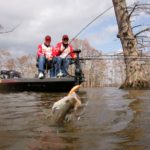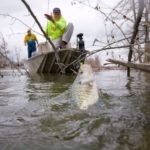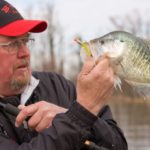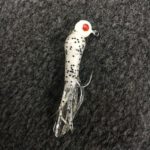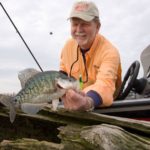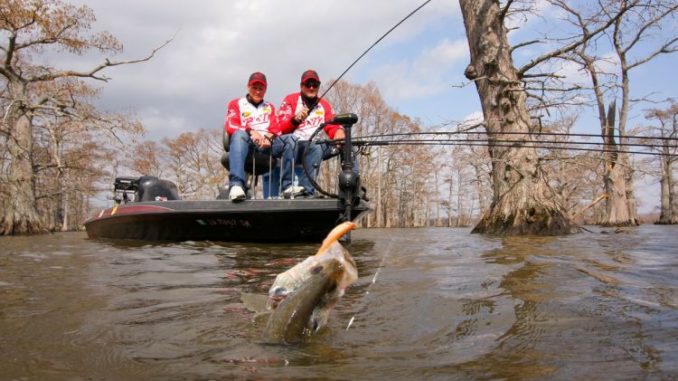
When the crappie spawn is wrapping up on D’Arbonne and Caney, action is usually just about to crank up on a section of the Ouachita River. Here’s how one guide still catches slabs in April.
Stuart Baum loves turning the last calendar page from March to April.
“I like February and March just as much,” he said, “but being able to turn the page to April means I get at least another month of being able to catch spawning crappie.”
By now Baum has already loaded his boat several times over with spawners he’s caught at Lake D’Arbonne and Caney Lake. But when April rolls around, he sets his sights on the Ouachita River between Felsenthal and Columbia.
“The Ouachita River is the last place I catch spawning crappie,” he said. “After they’re done spawning at D’Arbonne and Caney, they’re just getting started on the river.”
Of course the caveat for crappie spawning on the Ouachita River in April is that all bets are off if the river is being unruly.
“Normally, the water is high, cold and swift during March,” Baum said. “That prevents crappie from spawning as early as they do on the nearby lakes. By the time it starts to settle down in April — assuming it does — they finally get a chance to spawn without having so much going on.”
In fact, since Baum started guiding for crappie a few years ago (318-614-6830), he’s followed a three-month plan to put his customers on spawning fish from February to April every year: D’Arbonne in February, Caney in March and the Ouachita River in spring.
Find the ledge to get the edge
River crappie spawn differently than they do in D’Arbonne and Caney, and Baum knows the key to catching them is to pay attention to where the river used to be rather than where it is now.
“The pool level came up in the ‘60s when they put the locks in,” he said. “The old river bank from back then is still there, but it’s about 10 feet lower than what it is now. There are a lot of stumps, cypress knees and other submerged cover on that old bank where crappie stage to move up and spawn.”
The general principal is that crappie set up on this old Ouachita River ledge as they move up to spawn, then move back after spawning. This means there is just about always a large school of fish somewhere to be found on this ledge during April.
“They may spawn right there on the ledge,” Baum said, “but they may move up from that ledge to shallower water to spawn around the stumps, cypress knees, logs and grass beds on the bank at the new pool level.”
While this old ledge exists in the main river, Baum says there is generally still too much current for them to be attractive to crappie during April. Instead, crappie favor the old ledge in the river lakes, pockets and bayous.
“White’s Lake is a good one as is Hamilton Lake,” Baum pointed out. “Hamilton fishes a lot like another lake down around the Ouachita and Caldwell Parish line called Lake Lafitta. All three have that good 10-foot ledge that loads up with staging crappie.”
Good electronics are key
Finding these old ledges has been made really simple with the new electronics found on many modern boats. The clarity at which they show what’s down below the surface is far superior to older-model depth finders.
Baum spends a lot of time just idling around the river lakes watching his electronics.
“Nowadays you get a good depth finder with a Navionics or Hot Maps card and take a ride,” he said. “I might ride around for hours before I ever put a pole in the water. These things are so good today that I found some catfish nets on D’Arbonne with mine a while back — and could even see the catfish in them.”
Once he finds the ledge, Baum looks for signs of bait and crappie. Although he could move up to shallow water and catch a few here and a few there, Baum noted he would have to move around too much for his liking to find them.
So rather than look for isolated fish on the bank, Baum zig-zags over the ledge until he finds that magical spot where he knows he’s going to be able to hammer them in one location.
“Your biggest group of fish is going to be right there on that ledge,” he added. “I’d much rather fish for 16 in one spot than six scattered here and there.”
Along came a spider
Baum can typically be found spider-rigging the old river-bank ledge.
“That’s my go-to No. 1 technique,” he said. “If I’m tournament fishing, I fish with eight poles, but I normally like six if I’m just out fun fishing or have customers in the boat. For me that gives me three per hand, and for my customers they each get three poles if I have two people. I feel like I can catch more fish with six than eight because I can execute the bite better and miss fewer fish.”
Depending on how tough the bite is, Baum sets out 14- or 16-foot poles. He prefers the 14-foot poles if conditions allow him to get closer to the fish, but the 16-foot poles come out if he needs more distance between his boat and his bait.
“The tougher the bite the more distance I like to get out there,” he said. “Sometimes the fish are way up in the water column and sill spook away if the boat gets too close. Also, if it’s clear, I’ll put the longer poles out. Whichever I use, I like to put out all the same poles, the same line and the same reels to keep everything consistent.”
Before modern electronics, Baum would set out his baits at different depths then change them to the same depth once he figured out which one the fish were eating the most.
Now he starts off at the right depth based on what his electronics show him.
“Once I see how deep the crappie are, I try to set out all my baits about 6 inches to a foot over that,” Baum said. “Crappie feed up, so you definitely don’t want to be fishing under them.”
Baum prefers to fish the heaviest weights and biggest jigs that he can get away with. He most often reaches for 3-inch tube jigs and threads them onto ¼-ounce jigheads.
“Sometimes that big bait just stirs them up,” he said, “and I’d rather fish for bigger fish. Little ones will eat that big bait, too, but I tend to catch bigger fish on that bigger tube most of the time.”
Although he says it’s hard to beat a salt-and-pepper Midsouth jig on the Ouachita River, Baum doesn’t hesitate to switch if he needs to.
“I like the Midsouth jigs because they are so readily available at places like The Honey Hole in West Monroe,” Baum said. “But I also fish a lot of big minnows. Sometimes I fish all minnows. I don’t argue with the fish; I’m going to do whatever it takes to catch them. I keep a lot of different colors and sizes with me that I’ll pour through if I need to, but I pretty much always have a minnow tied on somewhere.”
The magic speed
Once he has his rods and baits all set out, Baum begins the process of learning which speed the fish want the baits presented.
“The key is finding that magic speed,” he said. “Sometimes they want it faster. Sometimes it’s a bump-and-go that works best. If you can find how fast they want your baits swimming in the water, you really get on them pretty good.”
Baum can figure out quickly whether the fish are there and willing to bite. If he knows they’re there, but not biting, he enjoys hanging around to figure out what he can do to make them eat.
“Sometimes I’ll have to fish straight down the ledge,” he said. “Other times I may have to crisscross the ledge back and forth. Then I may have to go straight across it in and out shallow to deep. It just depends on what they want. Every day can be different.”
If he’s got customers, though, he likes to move around to find another school that’s more willing to bite. As many backwaters as the Ouachita River has, he knows there’s likely another spot just around the corner that may pay off big time.
River conditions
Since the river can be in such a state of flux this time of year, Baum pointed to a few variables that he likes to see to stack the odds in his favor.
“The best case for me is for the water to be at a standstill or on a fall,” he said. “Although I caught them pretty well on a rise last year, that’s not the norm. Rising water generally spreads them out in all the newly flooded cover and makes it harder to find them.”
Baum catches some big crappie on the river during April. An average-sized good one would be about 1 ¾ pounds, but fish up to 2 pounds can be caught fairly regularly (although that definitely wouldn’t be a typical-size fish.)
If you’ve been spending the last two months crushing crappie on D’Arbonne or Caney, don’t worry about the end of the spawn leaving you high and dry. Just head to the Ouachita River and you can stay on spawning fish for at least another month.
